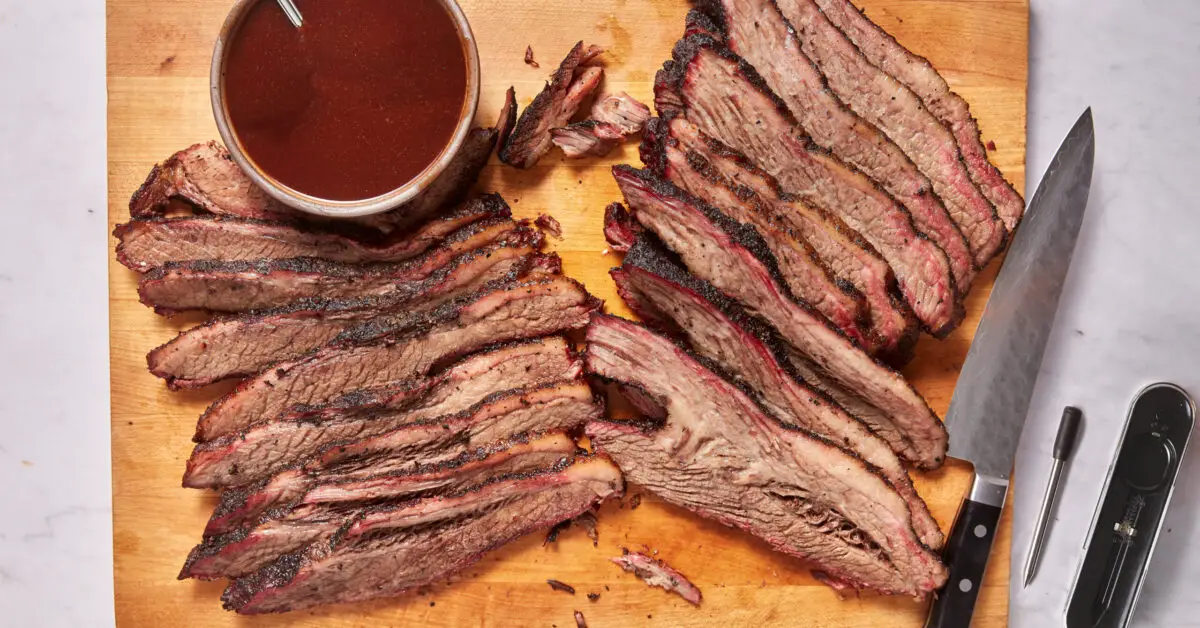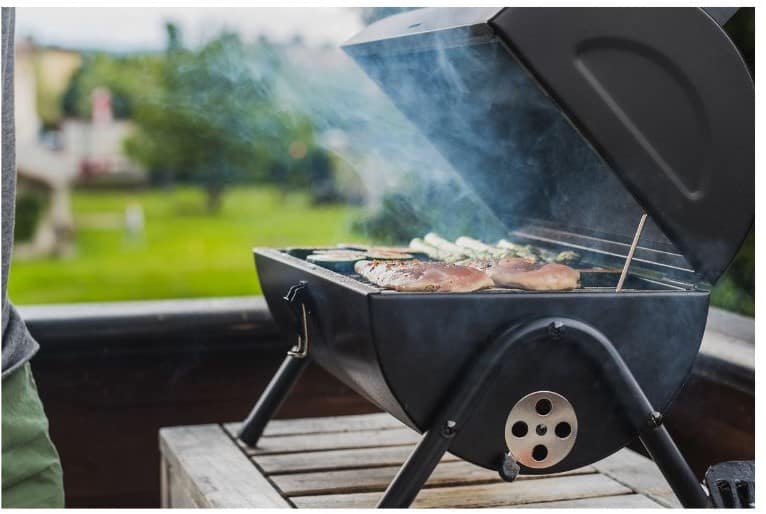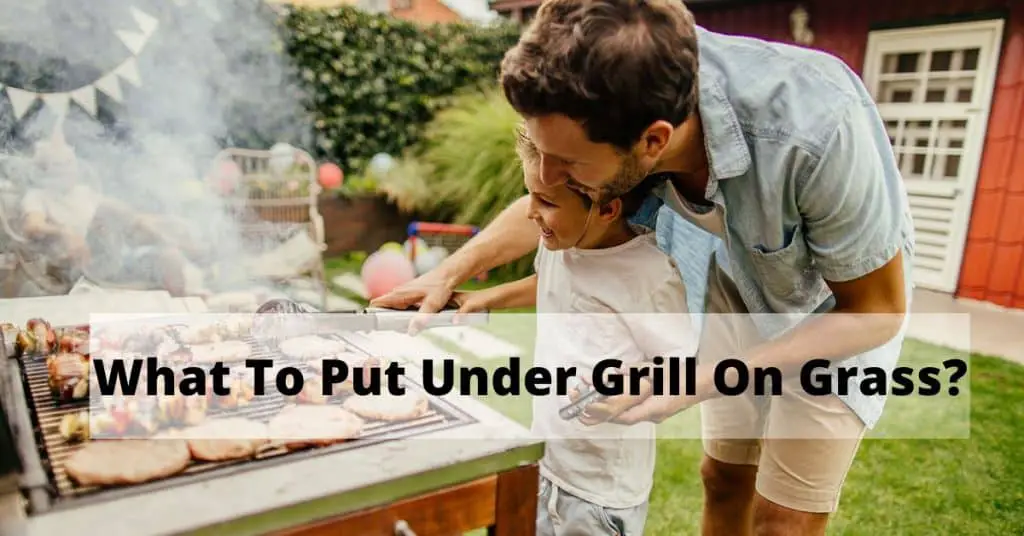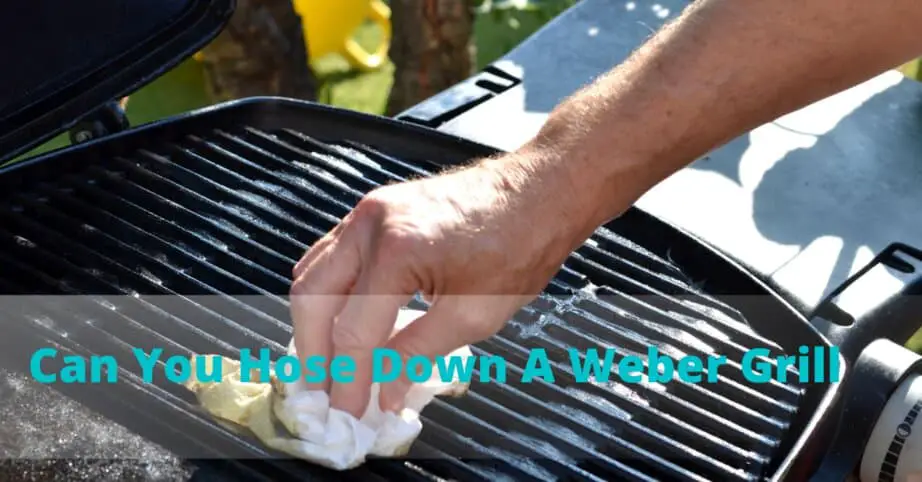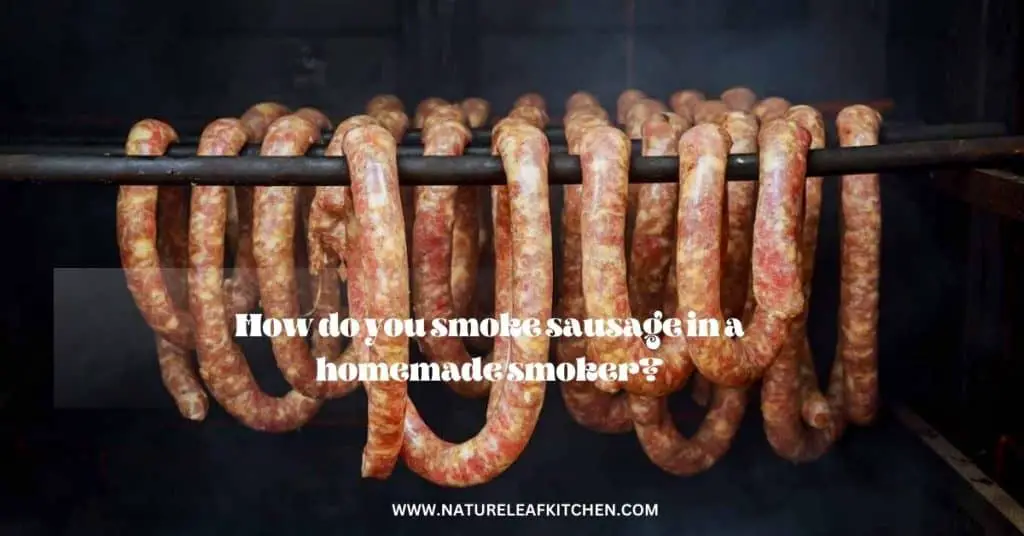To smoke a brisket on a Weber grill, first set up your grill for indirect heat and maintain a temperature of 225-250°F. Place the brisket fat-side up on the grate, and let it cook for 1-1.5 hours per pound.
Smoking a brisket to perfection on a Weber grill can transform your backyard barbecue into an event to remember. Crafting that melt-in-your-mouth brisket with a voluptuous smoke ring is about slow cooking and patience. Whether you’re using a traditional Weber charcoal grill or a gas model, mastering the art of smoking takes both skill and a solid understanding of the process.
Brisket, a tough piece of meat rich in collagen, rewards the diligent with unparalleled flavor and tenderness when done right. Equipping yourself with a reliable thermometer and good quality wood chips will help in achieving that coveted balance of smoky crust and juicy interior. Let’s dive into the key steps to help ensure your brisket becomes the highlight of your culinary efforts.
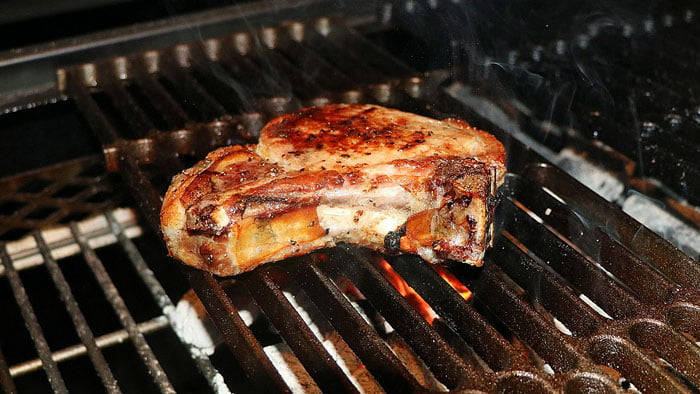
Credit: amazingribs.com
Selecting The Perfect Brisket
The journey to smoking a delectable brisket begins with picking the right cut. A great brisket serves as the foundation for the flavors and textures you’ll savor after hours of slow cooking. Let’s explore the secrets to selecting the best brisket for your Weber grill experience.
Choosing The Right Cut
The perfect brisket consists of two parts: the flat and the point. The flat is leaner, while the point contains more fat. To ensure even cooking, look for a brisket with thick, uniform marbling and a flat that maintains consistent thickness across its length.
Understanding Meat Grades
Different meat grades impact brisket quality. The USDA grades beef based on marbling and age. Select one of the top three grades – Prime, Choice, or Select – for the best results.
| Grade | Marbling | Tenderness |
|---|---|---|
| Prime | Abundant | Very Tender |
| Choice | Moderate | Tender |
| Select | Slight | Less Tender |
Freshness Matters
Choose a brisket that looks fresh and bright red. It should have a firm texture and not feel slimy. Check the sell-by date to ensure it’s within the optimal range for freshness.
- Color: Bright red, not browned
- Texture: Firm, springs back when pressed
- Odor: Should not have any off smells
Essential Tools And Supplies
Embracing the art of smoking a brisket on a Weber Grill requires some essential tools and supplies. Without the right gear, achieving that perfect smoky flavor and tender texture can be a challenge. Let’s dive into what you’ll need for this mouth-watering endeavor.
The Right Grill Setup
Choosing a suitable Weber Grill is the first step in your brisket adventure. Ensure it’s spacious enough to accommodate a whole brisket. Confirm it has a lid for maintaining consistent temperatures. For an optimal experience, a grill with a built-in thermometer helps monitor the cooking environment.
Accessories For Smoking
- Meat thermometer – Essential for checking brisket doneness.
- Smoking box or basket – Holds wood chips or chunks.
- Aluminum foil – Helps in wrapping the brisket.
- Drip pans – Capture drippings for a clean grill.
- Grilling gloves – Protect hands from heat.
- Grill brush – Essential for post-cook cleanup.
Selecting Wood For Smoke
Choosing the right wood impacts the brisket’s final flavor. Use hardwood chunks or chips like oak, hickory, or mesquite. Different woods offer unique taste notes:
| Wood Type | Flavor Profile |
|---|---|
| Oak | Mild and smoky |
| Hickory | Strong and bacon-like |
| Mesquite | Intense and earthy |
For a balanced taste, mixing wood types can also be an option.
Prepping Your Brisket For Smoke
Are you dreaming of crafting that perfect smoky brisket right in your backyard? Let’s turn that dream into a scrumptious reality! The first step to brisket glory on your Weber grill is all in the prep. By following these key steps, your brisket will not only take on an incredible smoky flavor but also have the perfect texture and juice that will make your mouth water.
Trimming The Fat
A well-trimmed brisket is the secret to even cooking. Start with a sharp knife and trim off the hard fat. Leave about 1/4 inch of fat cap for moisture and flavor. Here’s how to do it:
- Place brisket fat-side up on your cutting board.
- Identify the white, thick fat, and slice it away.
- Smooth out the remaining fat cap to an even thickness.
Seasoning Like A Pro
Seasoning is more than just adding flavor, it’s about creating a bark that’s irresistible. Use these guidelines:
- Dry your brisket with paper towels for better spice adhesion.
- Generously rub your choice of spices onto every inch of the brisket.
- Let the brisket sit with the rub for at least 1 hour before smoking.
To Inject Or Not To Inject
The injection can be a game-changer for moisture and flavor distribution. Consider these points:
| Pros | Cons |
|---|---|
| Enhances juiciness | Additional prep time |
| Infuses flavor deep within | Potential for uneven distribution if not done carefully |
| Can help tenderize the meat | May not be necessary for high-quality brisket |
Mull it over based on your brisket’s needs. If you decide to inject, do so evenly across the brisket to prevent flavor pockets.
Mastering The Weber Grill Setup
Welcome to the art of smoking a brisket on a Weber grill. When done right, smoking meat can transform a tough cut into a tender, flavorful feast. Let’s ensure your Weber is set up to take you to brisket paradise.
Configuring Your Grill For Smoking
To start, configure your Weber grill for indirect heat. This is key for a successful smoke.
- Place charcoal briquettes on one side of the grill.
- Add a few chunks of wood onto the coals for smoke flavor.
- Ensure the opposite side is free of coals for the meat.
Light the charcoal and wait for it to ash over. Once ready, set the brisket on the grate away from the direct heat, closing the lid to begin the process.
Maintaining Temperature Control
To maintain a constant temperature:
- Keep the lid closed as much as possible.
- Use the vents to adjust airflow. More air increases heat.
For a brisket, aim to keep the grill between 225-250°F. A meat thermometer will be your best guide.
Using Water Pans For Moisture
Water pans add moisture to the grill and help regulate temperature.
- Fill a metal pan with water and position it between the coals and meat.
- The evaporating water creates a humid environment, essential for keeping the brisket juicy.
Refill the pan as needed during the smoking process to prevent it from drying out.
The Smoking Process Unveiled
Welcome to ‘The Smoking Process Unveiled’, where we will walk through the secrets of making a perfect smoked brisket on your Weber Grill. Smoking brisket is an art that balances fire, smoke, and time. Unlock the flavors hidden within this tough cut of meat by following these steps.
Starting Your Fire
First things first, a consistent fire sets the foundation for smoking a brisket. Follow these steps:
- Choose high-quality briquettes or lump charcoal for a steady burn.
- For the Weber grill, use the snake method. Arrange briquettes in a semi-circle around the grill’s edge.
- Place wood chunks on top of the charcoal. Choose hickory or oak for a classic brisket taste.
- Light one end of the charcoal snake to create a gradual burn. This method ensures long-lasting heat.
Managing Smoke And Heat
Correctly managing smoke and heat is crucial:
-
- Keep the grill’s lid closed as much as possible to maintain temperature and smoke.
- Monitor the temperature closely, aiming for a consistent range between 225-250°F (107-121°C).
Use a grill thermometer for precision. Adjust vents to control airflow and temperature.
- Refill the charcoal and wood as needed to keep the smoke constant.
The Low And Slow Philosophy
Brisket’s texture transforms under prolonged, gentle cooking:
- Cooking brisket is a marathon, not a sprint. Patiently smoke the meat at low heat.
- Expect the process to take anywhere from 8 to 20 hours depending on brisket size.
- Use an internal meat thermometer. Aim for an internal temperature of 195-203°F (90-95°C) for perfect tenderness.
- Rest the brisket wrapped in butcher paper or foil for at least one hour before slicing.
The journey to a mouthwatering brisket is long, but each step is vital. Master these techniques and savor the results of true barbecue craft.
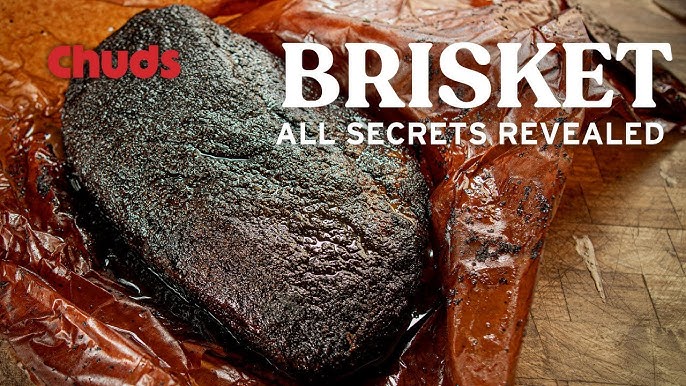
Credit: www.youtube.com
Monitoring Your Brisket
Monitoring your brisket is a critical step in the smoking process. It’s the difference between a juicy, flavorful feast and a tough, disappointing meal. Keep a close eye on your brisket with these tips to ensure smoking success on your Weber grill.
Probing For Tenderness
The true test of brisket readiness lies in its tenderness. Forget time schedules; your brisket should feel like warm butter when probed. Use a probe and slide it into different parts of the brisket. If it meets resistance, give it more time.
When To Wrap Your Brisket
Wrapping your brisket can prevent it from drying out. Look for the brisket’s color change — a rich, mahogany is your cue. It’s often around 150°F to 170°F. Wrap it in butcher paper or foil to lock in moisture and flavor.
Using Thermometers Effectively
An accurate read on the internal temperature ensures a perfect brisket. Place a digital thermometer in the thickest part, avoiding the fat. Aim for a final temp of about 195°F to 205°F, where collagen breaks down and brisket becomes sumptuously tender.
- Check the temperature regularly.
- Avoid frequent lid opening to maintain a consistent temperature.
Navigating The Stall And Crutch Techniques
Mastering brisket on a Weber grill delights taste buds but demands patience. The journey is long. Surprises like ‘the stall’ may appear. Fear not. Strategies like the ‘crutch technique’ ensure triumph. Below, unravel the mysteries of taming the stall with wisdom and foil or butcher paper.
What Is ‘the Stall’?
The ‘stall’, a common phenomenon, baffles many pitmasters. It refers to a period during cooking when the brisket’s internal temperature plateaus. Despite steady grill heat, temperatures linger stubbornly. This suspenseful pause is a natural process. It happens as meat moisture evaporates, cooling the brisket like sweat on skin.
Wrapping With Foil Or Butcher Paper
Wrapping offers a solution. When the stall strikes, envelop the brisket in aluminum foil or butcher paper. Both act as armor, trapping heat and moisture. Foil is known as the ‘Texas Crutch’, a popular ally for speeding the cook. Butcher paper breathes more, enhancing flavor and bark. The choice defines the character of the dish:
- Foil: Locks in moisture, ensures tenderness and speeds up cooking.
- Butcher Paper: Preserves texture, allows smoke infusion, and builds crust.
Adjusting Heat During The Stall
Maintain composure when heat feels uncooperative. Adjusting the grill temperature may be necessary. A small uptick in heat introduces renewed momentum. Keep the change mild. Overzealous heat spikes threaten the meat’s integrity. A gentle approach, like reinforcing a struggling friend, steers brisket safely through its plateau:
| Condition | Action |
|---|---|
| Temperature Stall | Small Increase |
| Heat Conservation | Wrap Brisket |
| Continued Cooking | Monitor Closely |
Rest And Serve
After meticulously smoking your brisket on a Weber grill, you’ve reached the critical ‘Rest and Serve’ phase. This step is crucial: it’s when the brisket absorbs its own juices back, guaranteeing a moist and flavorful slice. In this section, we dive into the proper rest, how to carve your masterpiece, and the best accompaniments to turn your brisket into a sumptuous feast.
The Importance Of Resting Meat
Think of resting as the final touch to your smoking artistry. Resting allows the fibers in the brisket to relax and reabsorb the juices that have been mobilized during cooking. Plan for a rest time of around 1 hour, wrapped in foil and a towel, then placed in a cooler. It’s the secret to a tender, juicy brisket that’s bursting with flavor.
Carving The Brisket
- Use a sharp knife for clean cuts.
- Locate the grain of the meat and slice it against it.
- Start with the flat end, slicing thinly; move to the point end for thicker, juicier slices.
- Carve just before serving to preserve moisture.
Pairing With Sides And Sauces
The right sides and sauces can elevate your brisket. Consider these crowd-pleasers:
| Sides | Sauces |
|---|---|
|
|
Mix and match to please your palate. Remember, the brisket is the star, so complement, don’t overshadow.
Troubleshooting Common Issues
Welcome to the heart of smoking meats – the brisket challenge.
Even expert grill masters face hiccups while smoking a brisket on a Weber grill.
Let’s troubleshoot common issues to ensure your next smoke is flawless.
Overcoming Overcooking
It’s disheartening to find the brisket overdone.
Consistent temperature checks are key to avoidance.
Here’s a quick fix to reverse slight overcooking:
- Remove brisket from heat immediately.
- Wrap in foil and a towel.
- Place in a cooler to stop the cooking process.
Keep a digital thermometer handy and monitor the internal temperature.
Aim for 195-205°F for perfect tenderness.
Dealing With Undercooked Meat
Undercooking can be equally disheartening.
Here’s how to ensure your brisket reaches ideal doneness:
- Check for an internal temp of 195°F.
- If the meat’s tough, keep cooking at low heat.
- Patience is key; brisket can take up to 12 hours.
Remember, brisket continues to cook after it’s off the grill.
Allow it to rest before serving.
Managing Flare-ups And Burnt Ends
Flare-ups can turn crisp ends into charred bits.
Control these outbreaks and achieve ideal burnt ends with these steps:
| Action | Effect |
|---|---|
| Trim excess fat. | Reduces flare-up chance. |
| Maintain low temperature. | Ensures even cooking. |
| Monitor the grill often. | Catches flare-ups early. |
Using indirect heat can also prevent burnt ends.
Place brisket away from direct flames and close the lid.
This will allow for a smoky crust without over-charring.
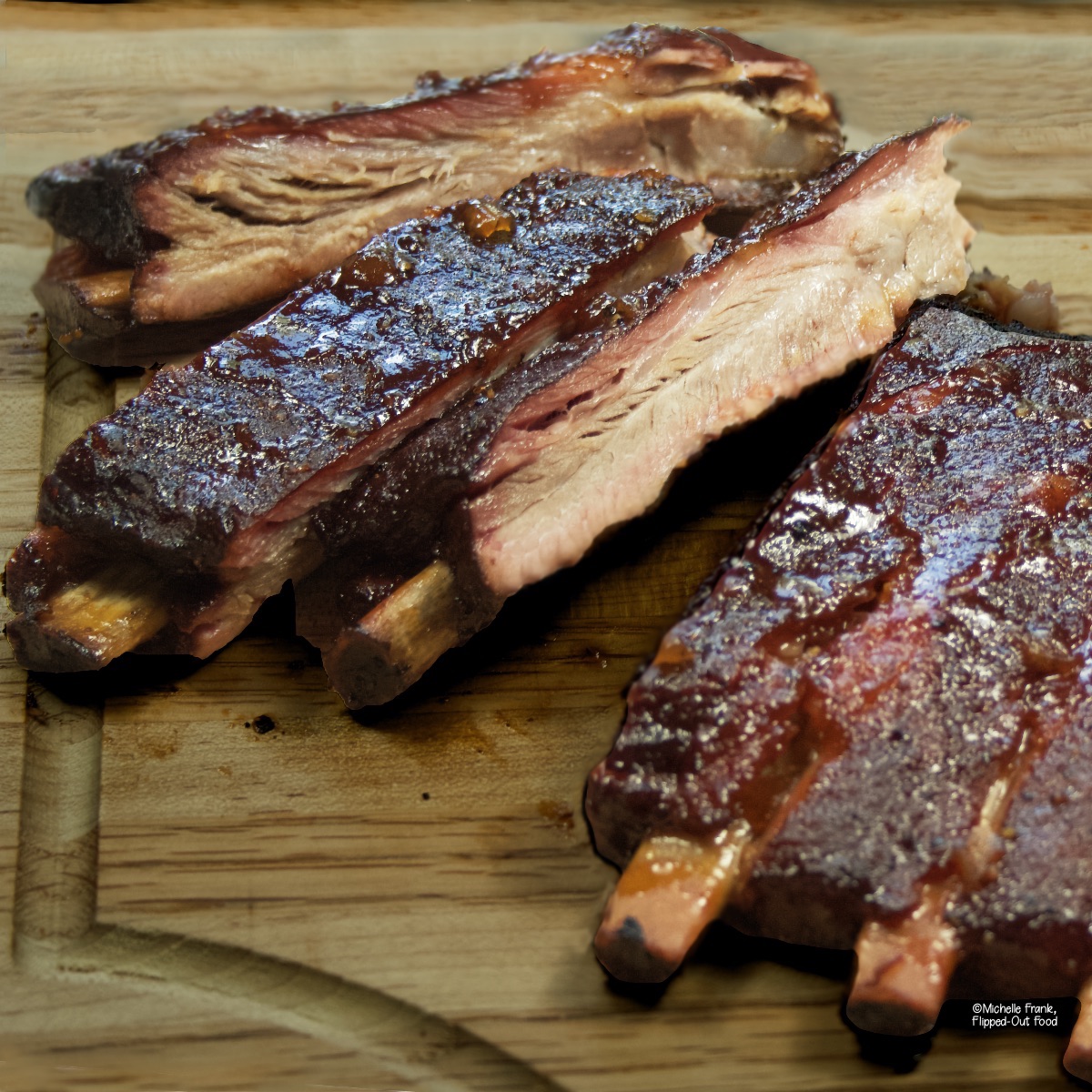
Credit: www.flippedoutfood.com
Expanding Your Smoky Horizons
Welcome to the sizzling world of brisket smoking on your trusted Weber grill! As you master the basics, you’re now ready to expand your smoky horizons. This guide will pave the path for new dimensions of flavor that are sure to impress your taste buds and wow your guests. Embark on this smoking adventure and let’s elevate your brisket game together!
Trying New Rubs And Marinades
Unlock the full potential of your brisket with bold rubs and specialty marinades. Each new concoction brings its unique twist. Using fresh ingredients and spices will season the meat deeply, providing a taste that lingers with every bite.
- Spicy Kick: Combine paprika, garlic powder, and cayenne to heat things up.
- Sweet Temptation: Mix brown sugar and mustard powder for a caramelized crust.
- Herbal Freshness: Blend rosemary, thyme, and black pepper for a garden-fresh aroma.
Different Woods For New Flavors
The choice of wood can significantly influence the flavor of your smoked brisket. Experiment with a variety of wood chips to find your signature smoke profile.
| Wood Type | Flavor Profile |
|---|---|
| Hickory | Robust and bacon-like |
| Cherry | Sweet and fruity |
| Mesquite | Strong and earthy |
| Apple | Mild and subtly sweet |
Advanced Smoking Techniques
Ready to take your smoking skills up a notch? Let’s delve into advanced techniques that can intensify the brisket’s flavor and tenderness.
- Use a water pan to maintain moisture during long smoking sessions.
- Try the Texas Crutch method by wrapping the brisket in foil after the initial smoke.
- Implement two-zone cooking, using indirect heat to smoke the brisket slowly.
Each twist and turn on your brisket smoking journey adds layers of flavor and excitement to your culinary repertoire. Experiment with confidence and revel in the delicious discoveries that await!
Frequently Asked Questions For How To Smoke A Brisket On A Weber Grill
What Temperature To Smoke Brisket On Weber?
Maintain a steady 225-250°F in your Weber grill to ensure the brisket smokes perfectly, resulting in tender, juicy meat.
How Long To Smoke A Brisket On A Weber?
A brisket typically requires 1 to 1. 5 hours per pound to smoke on a Weber grill, so plan for a full day of cooking for larger cuts.
Should I Wrap My Brisket While Smoking?
Wrapping your brisket in foil or butcher paper once it reaches 150-170°F can speed up cooking and help preserve moisture, but it’s optional.
Conclusion
Mastering the art of smoking a brisket on your trusty Weber grill can utterly transform your outdoor cooking experiences. With patience and practice, you’ll carve into tender, smoke-infused beef that impresses guests and satisfies cravings. Remember the key steps: maintain consistent temperatures, manage the smoke, and rest the meat properly.
Now, fire up that grill, apply your new insights, and ready yourself for a mouthwatering feast!
